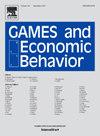A direct proof of the short-side advantage in random matching markets
IF 1
3区 经济学
Q3 ECONOMICS
引用次数: 0
Abstract
We study the stable matching problem under the random matching model where the preferences of the doctors and hospitals are sampled uniformly and independently at random. In a balanced market with n doctors and n hospitals, the doctor-proposing deferred-acceptance algorithm gives doctors an expected rank of order for their partners and hospitals an expected rank of order for their partners (Pittel, 1989; Wilson, 1972). This situation is reversed in an unbalanced market with doctors and n hospitals (Ashlagi et al., 2017), a phenomenon known as the short-side advantage. The current proofs (Ashlagi et al., 2017; Cai and Thomas, 2022) of this fact are indirect, counter-intuitively being based upon analyzing the hospital-proposing deferred-acceptance algorithm. In this paper we provide a direct proof of the short-side advantage, explicitly analyzing the doctor-proposing deferred-acceptance algorithm. Our proof sheds light on how and why the phenomenon arises.
随机匹配市场中空头优势的直接证明
研究了随机匹配模型下的稳定匹配问题,其中医生和医院的偏好是均匀独立随机抽样的。在一个有n名医生和n家医院的均衡市场中,医生提出的延迟接受算法为医生的合作伙伴提供了阶log (n)的期望秩,为医院的合作伙伴提供了阶nlog (n)的期望秩(Pittel, 1989; Wilson, 1972)。在拥有n+1名医生和n家医院的不平衡市场中,这种情况正好相反(Ashlagi et al., 2017),这种现象被称为短面优势。目前对这一事实的证明(Ashlagi et al., 2017; Cai and Thomas, 2022)是间接的,与直觉相反,是基于对医院提议延迟接受算法的分析。在本文中,我们提供了短边优势的直接证明,明确地分析了医生建议延迟接受算法。我们的证据揭示了这种现象是如何以及为什么产生的。
本文章由计算机程序翻译,如有差异,请以英文原文为准。
求助全文
约1分钟内获得全文
求助全文
来源期刊

Games and Economic Behavior
ECONOMICS-
CiteScore
1.90
自引率
9.10%
发文量
148
期刊介绍:
Games and Economic Behavior facilitates cross-fertilization between theories and applications of game theoretic reasoning. It consistently attracts the best quality and most creative papers in interdisciplinary studies within the social, biological, and mathematical sciences. Most readers recognize it as the leading journal in game theory. Research Areas Include: • Game theory • Economics • Political science • Biology • Computer science • Mathematics • Psychology
 求助内容:
求助内容: 应助结果提醒方式:
应助结果提醒方式:


